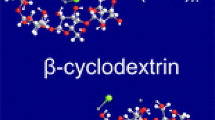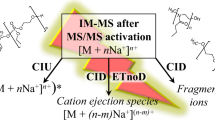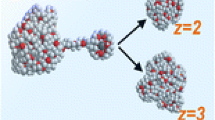Abstract
The collisionally activated dissociation (CAD) and electron capture dissociation (ECD) of doubly charged tocopheryl polyethylene glycol succinate (TPGS) have been examined. Li+, Na+, K+, Ag+, and H+ were selected in the study, and the competitive influence of each ion was investigated by fragmenting TPGS attached with two different cations, [M + X1 + X2]2+ (X1 and X2 refer to Li+, Na+, K+, Ag+, H+). For metallic adducts, CAD results show that the dissociation of ionic adducts from the precursor is most likely depending on the binding strength, where the affinity of each ion to the TPGS is in the order of Ag+ ≈ Li+ ˃ Na+ ˃ K+. Introducing more strongly bound adducts increases fragmentation. During ECD, however, the silver cation is lost most easily compared with the other alkali metal ions, but silver also shows a dominant role in producing fragmentations. Moreover, the charge carriers are lost in an order (Ag+ ˃ Na+ ˃ K+ ≥ Li+ where the loss of Ag is most easily) that appears to correlate with the standard reduction potential of the metallic ions (Ag+ ˃ Na+ ˃ K+ ˃ Li+). The ECD results suggest that the reduction potential of the charge carrier could be an important factor influencing the fragmentation, where the ion with a high reduction potential is more effective in capturing electrons, but may also be lost easily before leading to any fragmentation. Finally, a proton has the weakest binding with the TPGS according to the CAD results, and its dissociation in ECD follows the order of the reduction potential (Ag+ ˃ H+ ˃ Na+ ˃ K+ > Li+).

ᅟ







Similar content being viewed by others
References
Rashidezadeh, H., Guo, B.: Investigation of metal attachment to polystyrenes in matrix-assisted laser desorption ionization. J. Am. Soc. Mass Spectrom. 9, 724–730 (1998)
Kuki, Á., Nagy, L., Shemirani, G., Memboeuf, A., Drahos, L., Vékey, K., Zsuga, M., Kéki, S.: A simple method to estimate relative stabilities of polyethers cationized by alkali metal ions. Rapid Commun. Mass Spectrom. 26, 304–308 (2012)
Kéki, S., Nagy, L., Deák, G., Zsuga, M.: Multiple charging of poly (propylene glycol) by binary mixtures of cations in electrospray. J. Am. Soc. Mass Spectrom. 16, 152–157 (2005)
Li, X., Guo, L., Casiano-Maldonado, M., Zhang, D., Wesdemiotis, C.: Top-down multidimensional mass spectrometry methods for synthetic polymer analysis. Macromolecules 44, 4555–4564 (2011)
Nielen, M.W.: MALDI time-of-flight mass spectrometry of synthetic polymers. Mass Spectrom. Rev. 18, 309–344 (1999)
Kéki, S., Deák, G., Zsuga, M.: Copper(I) chloride: a simple salt for enhancement of polystyrene cationization in matrix-assisted laser desorption/ionization mass spectrometry. Rapid Commun. Mass Spectrom. 15, 675–678 (2001)
Gidden, J., Wyttenbach, T., Jackson, A.T., Scrivens, J.H., Bowers, M.T.: Gas-phase conformations of synthetic polymers: Poly(ethylene glycol), poly(propylene glycol), and poly(tetramethylene glycol). J. Am. Chem. Soc. 122, 4692–4699 (2000)
Nasioudis, A., Joyce, W.F., Velde, J.W.V., Heeren, R.M.A., Brink, O.F.V.D.: Formation of low charge state ions of synthetic polymers using quaternary ammonium compounds. Anal. Chem. 82, 5735–5742 (2010)
Yu, X., Huang, Y., Lin, C., Costello, C.E.: Energy-dependent electron activated dissociation of metal-adducted permethylated oligosaccharides. Anal. Chem. 84, 7487,7494 (2012)
Adamson, J.T., Håkansson, K.: Electron capture dissociation of oligosaccharides ionized with alkali, alkaline earth, and transition metals. Anal. Chem. 79, 2901–2910 (2007)
Cancilla, M.T., Penn, S.G., Carroll, J.A., Lebrilla, C.B.: Coordination of alkali metals to oligosaccharides dictates fragmentation behavior in matrix assisted laser desorption ionization/Fourier transform mass spectrometry. J. Am. Chem. Soc. 118, 6736–6745 (1996)
Ropartz, D., Bodet, P.-E., Przybylski, C., Gonnet, F., Daniel, R., Fer, M., Helbert, W., Bertrand, D., Rogniaux, H.: Performance evaluation on a wide set of matrix-assisted laser desorption ionization matrices for the detection of oligosaccharides in a high-throughput mass spectrometric screening of carbohydrate depolymerizing enzymes. Rapid Commun. Mass Spectrom. 25, 2059–2070 (2011)
Liu, H., Håkansson, K.: Divalent metal ion-peptide interactions probed by electron capture dissociation of trications. J. Am. Soc. Mass Spectrom. 17, 1731–1741 (2006)
Mosely, J., Murray, B., Parker, D.: Electron-capture dissociation and collision-induced dissociation of lanthanide metal–ligand complexes and lanthanide metal–ligand complexes bound to phosphopeptides. Eur. J. Mass Spectrom. 15, 145–155 (2009)
Fung, Y.M.E., Liu, H., Chan, T.W.D.: Electron capture dissociation of peptides metalated with alkaline-earth metal ions. J. Am. Soc. Mass Spectrom. 17, 757–771 (2006)
Flick, T., Donald, W., Williams, E.: Electron capture dissociation of trivalent metal ion–peptide complexes. J. Am. Soc. Mass Spectrom. 24, 193–201 (2013)
Iavarone, A.T., Paech, K., Williams, E.R.: Effects of charge state and cationizing agent on the electron capture dissociation of a peptide. Anal. Chem. 76, 2231–2238 (2004)
Lattimer, R.P.: Tandem mass spectrometry of lithium-attachment ions from polyglycols. J. Am. Soc. Mass Spectrom. 3, 225–234 (1992)
Gidden, J., Bowers, M.T., Jackson, A.T., Scrivens, J.H.: Gas-phase conformations of cationized poly(styrene) oligomers. J. Am. Soc. Mass Spectrom. 13, 499–505 (2002)
Selby, T.L., Wesdemiotis, C., Lattimer, R.P.: Dissociation characteristics of [M + X]+ ions (X= H, Li, Na, K) from linear and cyclic polyglycols. J. Am. Soc. Mass Spectrom. 5, 1081–1092 (1994)
Chen, R., Li, L.: Lithium and transition metal ions enable low energy collision-induced dissociation of polyglycols in electrospray ionization mass spectrometry. J. Am. Soc. Mass Spectrom. 12, 832–839 (2001)
Wallow, T.I., Novak, B.M.: In aqua synthesis of water-soluble poly (p-phenylene) derivatives. J. Am. Chem. Soc. 113, 7411–7412 (1991)
McNeill, I.C., Zulfiqar, M.: Preparation and degradation of salts of poly(methacrylic acid). I. Lithium, sodium, potassium, and caesium salts. J. Polym. Sci. A 16, 3201–3212 (1978)
Gao, S., Zhang, Z.-P., Karnes, H.T.: Sensitivity enhancement in liquid chromatography/atmospheric pressure ionization mass spectrometry using derivatization and mobile phase additives. J. Chromatogr. B 825, 98–110 (2005)
Vékey, K., Memboeuf, A., Lendvay, G.: Structure and energetics of poly(ethylene glycol) cationized by Li+, Na+, K+, and Cs+: a first-principles study. Eur. J. Mass Spectrom. 17, 33–46 (2011)
Bogan, M.J., Agnes, G.R.: Poly(ethylene glycol) doubly and singly cationized by different alkali metal ions: relative cation affinities and cation-dependent resolution in a quadrupole ion trap mass spectrometer. J. Am. Soc. Mass Spectrom. 13, 177–186 (2002)
Miladinović, S.M., Kaeser, C.J., Knust, M.M., Wilkins, C.L.: Tandem Fourier transform mass spectrometry of block and random copolymers. Int. J. Mass Spectrom. 301, 184–194 (2011)
Smith, M.J.P.: Doctor of Philosophy. Durham University, UK (2013)
Girod, M., Carissan, Y., Humbel, S., Charles, L.: Tandem mass spectrometry of doubly charged poly (ethylene oxide) oligomers produced by electrospray ionization. Int. J. Mass Spectrom. 272, 1–11 (2008)
Cerda, B., Horn, D., Breuker, K., Carpenter, B., McLafferty, F.: Electron capture dissociation of multiply-charged oxygenated cations. A nonergodic process. Eur. J. Mass Spectrom. 5, 335–338 (1999)
Kaczorowska, M.A., Cooper, H.J.: Characterization of polyphosphoesters by Fourier transform ion cyclotron resonance mass spectrometry. J. Am. Soc. Mass Spectrom. 20, 2238–2247 (2009)
Cerda, B.A., Horn, D.M., Breuker, K., McLafferty, F.W.: Sequencing of specific copolymer oligomers by electron-capture-dissociation mass spectrometry. J. Am. Chem. Soc. 124, 9287–9291 (2002)
Scionti, V., Wesdemiotis, C.: Electron transfer dissociation versus collisionally activated dissociation of cationized biodegradable polyesters. J. Mass Spectrom. 47, 1442–1449 (2012)
Koster, S., Duursma, M., Boon, J., Heeren, R.A., Ingemann, S., Benthem, R.T.M., Koster, C.: Electron capture and collisionally activated dissociation mass spectrometry of doubly charged hyperbranched polyesteramides. J. Am. Soc. Mass Spectrom. 14, 332–341 (2003)
Chen, X., Fung, Y., Chan, W., Wong, P., Yeung, H., Chan, T.W.D.: Transition metal ions: charge carriers that mediate the electron capture dissociation pathways of peptides. J. Am. Soc. Mass Spectrom. 22, 2232–2245 (2011)
Wills, R.H., Tosin, M., O’Connor, P.B.: Structural characterization of polyketides using high mass accuracy tandem mass spectrometry. Anal. Chem. 84, 8863–8870 (2012)
Mosely, J.A., Smith, M.J.P., Prakash, A.S., Sims, M., Bristow, A.W.T.: Electron-induced dissociation of singly charged organic cations as a tool for structural characterization of pharmaceutical type molecules. Anal. Chem. 83, 4068–4075 (2011)
Wei, J., Bristow, A., McBride, E., Kilgour, D., O’Connor, P.B.: D-α-tocopheryl polyethylene glycol 1000 succinate: a view from FTICR MS and tandem MS. Anal. Chem. 86, 1567–1574 (2014)
Zhao, C., Sethuraman, M., Clavreul, N., Kaur, P., Cohen, R.A., O’Connor, P.B.: Detailed map of oxidative post-translational modifications of human P21Ras using Fourier transform mass spectrometry. Anal. Chem. 78, 5134–5142 (2006)
Caravatti, P., Allemann, M.: The ‘infinity cell’: a new trapped-ion cell with radiofrequency covered trapping electrodes for Fourier transform ion cyclotron resonance mass spectrometry. Org. Mass Spectrom. 26, 514–518 (1991)
Atkins, P., De Paula, J.: Elements of physical chemistry. Macmillan: pp. 216–220 (2009)
Paizs, B., Suhai, S.: Fragmentation pathways of protonated peptides. Mass Spectrom. Rev. 24, 508–548 (2005)
Wysocki, V.H., Tsaprailis, G., Smith, L.L., Breci, L.A.: Mobile and localized protons: a framework for understanding peptide dissociation. J. Mass Spectrom. 35, 1399–1406 (2000)
Acknowledgments
This work was supported by the Chancellor’s International Scholarships of Warwick, Warwick Centre for Analytical Science (EPSRC funded EP/F034210/1), the University of Warwick, and the Department of Chemistry. Special thanks are due to Dr. Mark P. Barrow, Andrew J. Soulby, Chris A. Wootton, Dr. David P. A. Kilgour, Dr Maria A. van Agthoven, and Samantha L. Benson from the University of Warwick.
Author information
Authors and Affiliations
Corresponding author
Electronic supplementary material
Below is the link to the electronic supplementary material.
ESM 1
(DOCX 108 kb)
Rights and permissions
About this article
Cite this article
Wei, J., Bristow, A.W.T. & O’Connor, P.B. The Competitive Influence of Li+, Na+, K+, Ag+, and H+ on the Fragmentation of a PEGylated Polymeric Excipient. J. Am. Soc. Mass Spectrom. 26, 166–173 (2015). https://doi.org/10.1007/s13361-014-1009-6
Received:
Revised:
Accepted:
Published:
Issue Date:
DOI: https://doi.org/10.1007/s13361-014-1009-6




